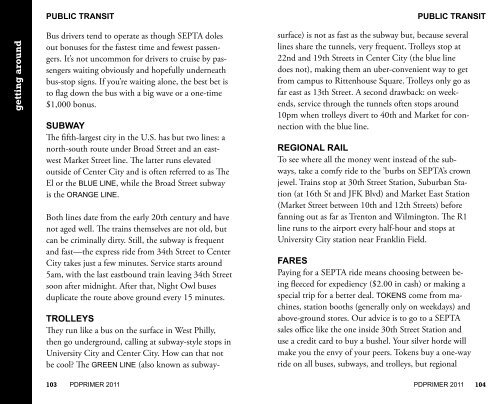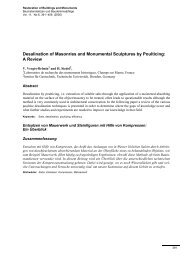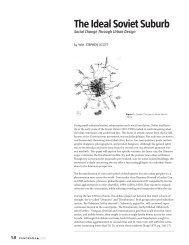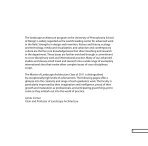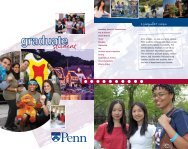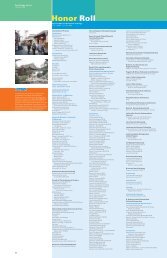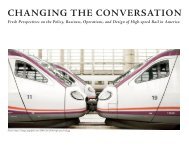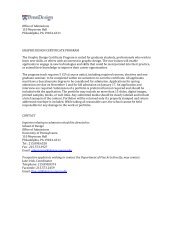PD Primer - PennDesign - University of Pennsylvania
PD Primer - PennDesign - University of Pennsylvania
PD Primer - PennDesign - University of Pennsylvania
Create successful ePaper yourself
Turn your PDF publications into a flip-book with our unique Google optimized e-Paper software.
getting around<br />
PUBLiC tRAnSit<br />
Bus drivers tend to operate as though SEPTA doles<br />
out bonuses for the fastest time and fewest passengers.<br />
It’s not uncommon for drivers to cruise by passengers<br />
waiting obviously and hopefully underneath<br />
bus-stop signs. If you’re waiting alone, the best bet is<br />
to flag down the bus with a big wave or a one-time<br />
$1,000 bonus.<br />
SUBWAY<br />
The fifth-largest city in the U.S. has but two lines: a<br />
north-south route under Broad Street and an eastwest<br />
Market Street line. The latter runs elevated<br />
outside <strong>of</strong> Center City and is <strong>of</strong>ten referred to as The<br />
El or the BlUE lINE, while the Broad Street subway<br />
is the ORaNGE lINE.<br />
Both lines date from the early 20th century and have<br />
not aged well. The trains themselves are not old, but<br />
can be criminally dirty. Still, the subway is frequent<br />
and fast—the express ride from 34th Street to Center<br />
City takes just a few minutes. Service starts around<br />
5am, with the last eastbound train leaving 34th Street<br />
soon after midnight. After that, Night Owl buses<br />
duplicate the route above ground every 15 minutes.<br />
tRoLLEYS<br />
They run like a bus on the surface in West Philly,<br />
then go underground, calling at subway-style stops in<br />
<strong>University</strong> City and Center City. How can that not<br />
be cool? The GREEN lINE (also known as subway-<br />
103 <strong>PD</strong>PRIMER 2011<br />
PUBLiC tRAnSit<br />
surface) is not as fast as the subway but, because several<br />
lines share the tunnels, very frequent. Trolleys stop at<br />
22nd and 19th Streets in Center City (the blue line<br />
does not), making them an uber-convenient way to get<br />
from campus to Rittenhouse Square. Trolleys only go as<br />
far east as 13th Street. A second drawback: on weekends,<br />
service through the tunnels <strong>of</strong>ten stops around<br />
10pm when trolleys divert to 40th and Market for connection<br />
with the blue line.<br />
REGionAL RAiL<br />
To see where all the money went instead <strong>of</strong> the subways,<br />
take a comfy ride to the ’burbs on SEPTA’s crown<br />
jewel. Trains stop at 30th Street Station, Suburban Station<br />
(at 16th St and JFK Blvd) and Market East Station<br />
(Market Street between 10th and 12th Streets) before<br />
fanning out as far as Trenton and Wilmington. The R1<br />
line runs to the airport every half-hour and stops at<br />
<strong>University</strong> City station near Franklin Field.<br />
FARES<br />
Paying for a SEPTA ride means choosing between being<br />
fleeced for expediency ($2.00 in cash) or making a<br />
special trip for a better deal. TOKENS come from machines,<br />
station booths (generally only on weekdays) and<br />
above-ground stores. Our advice is to go to a SEPTA<br />
sales <strong>of</strong>fice like the one inside 30th Street Station and<br />
use a credit card to buy a bushel. Your silver horde will<br />
make you the envy <strong>of</strong> your peers. Tokens buy a one-way<br />
ride on all buses, subways, and trolleys, but regional<br />
<strong>PD</strong>PRIMER 2011 104


